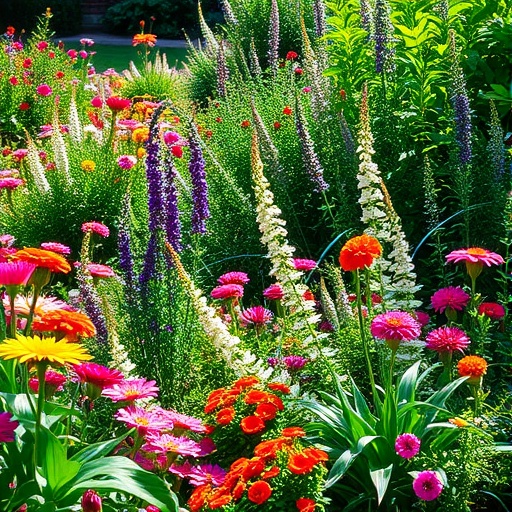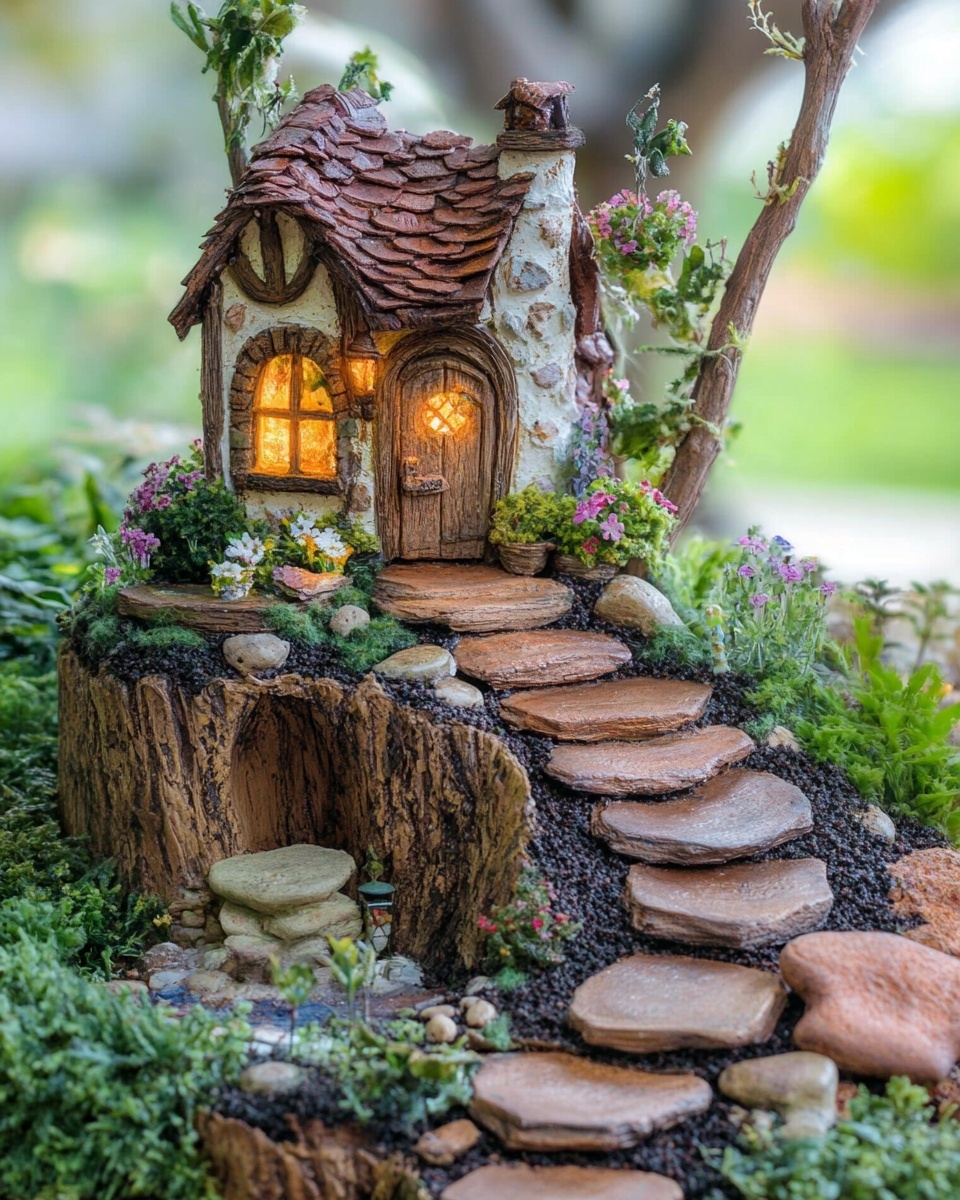Introduction
Did you know that over 70% of gardeners dream of a vibrant landscape that continuously bursts with color, yet many struggle to achieve this with annuals alone? Imagine stepping into your garden every day and being greeted by an evolving tapestry of blossoms, not just for a fleeting season, but year after year. This isn't just a fantasy; it's the beautiful reality awaiting you with well-planned perennial flower gardens. Unlike their one-season counterparts, perennials return reliably, offering enduring beauty and often requiring less effort over time. But where do you begin when curating these living masterpieces? How do you ensure a continuous display of floral artistry from early spring until late autumn? Let’s unearth the secrets to creating truly spectacular and low-maintenance perennial displays that will make your garden the envy of the neighborhood.
Tools & Materials Needed
Embarking on the journey of creating stunning perennial flower gardens requires a few essential companions. Think of these as your trusty gardening allies!
- Gardening Gloves: Essential for protecting your hands from soil, thorns, and blisters. Opt for breathable, water-resistant material.
- Small Hand Trowel: Perfect for digging individual planting holes, transplanting seedlings, and breaking up small clumps of soil. Consider one with an ergonomic handle.
- Garden Spade or Shovel: For larger digging tasks, turning over soil, and preparing planting beds. A stainless steel blade will last longer and resist rust.
- Garden Fork: Ideal for aerating soil, mixing in compost, and breaking up compacted earth without disturbing existing root systems too much.
- Pruners/Shears: A must-have for deadheading spent blooms, shaping plants, and trimming back foliage at the end of the season. Bypass pruners are typically best for live stems.
- Watering Can or Hose with a Gentle Sprayer: Consistent watering is crucial, especially during establishment. A gentle spray prevents young plants from being dislodged.
- High-Quality Potting Mix or Garden Soil Amendment: For enriching your existing soil. Look for organic options with good drainage and nutrient retention. A blend containing compost, aged manure, or peat moss is excellent.
- Mulch (e.g., wood chips, shredded leaves, pine needles): Helps retain soil moisture, suppress weeds, and regulate soil temperature.
- Perennial Flower Plugs or Seeds: Of course, the stars of your garden! For instant impact, choose established plugs. For a budget-friendly option and true gardening satisfaction, start from seeds.
- Optional – Soil Test Kit: To understand your soil's pH and nutrient levels, allowing for targeted amendments. Many cooperative extensions offer this service.
Eco-Friendly & Budget-Friendly Alternatives:
Instead of buying new plastic pots, repurpose old plastic containers for starting seeds. Use a sturdy stick or even your gloved hands in place of a trowel for smaller tasks. Collect rainwater in barrels for chemical-free irrigation. And for mulch, nothing beats the free, nutrient-rich benefits of shredded leaves from your own yard or local municipal yard waste programs!
Time & Effort Overview
Creating and maintaining beautiful perennial flower gardens is a rewarding endeavor that balance upfront effort with long-term benefits. Initial planting and bed preparation might take a weekend or two, especially for a new garden bed or significant overhaul. For example, preparing a 10×10 foot perennial bed from scratch (removing sod, amending soil) could easily be a 6-8 hour project. In contrast, planting a similar number of annuals typically takes about 25% less time initially, but then requires annual replanting.
Once established, the ongoing maintenance for perennials is generally moderate. Expect weekly watering during dry spells, especially in the first growing season. Deadheading (removing spent flowers) for continuous blooms can take 30 minutes to an hour per week for a medium-sized garden, depending on the number of plants. Compared to the continuous sowing and removal required by annuals, perennials offer a significant time-saving advantage in subsequent years.
Difficulty Level: This project is suitable for Intermediate gardeners, but enthusiastic beginners can certainly succeed with careful planning and a little patience. The primary challenges lie in proper plant selection for your climate and soil, and understanding basic pruning techniques. However, many easy-to-grow perennials are perfect for those just starting their perennial journey.
Step-by-Step Gardening Process
1. Planning Your Perennial Oasis
Before you lift a single trowel, careful planning is paramount for successful perennial flower gardens.
- Observe Your Space: Pay attention to sunlight exposure throughout the day. Does the area get full sun (6+ hours), partial sun (4-6 hours), or shade (less than 4 hours)? Note wind patterns and any existing features like fences or trees. Accurate light assessment is critical for plant success.
- Soil Assessment: Dig a small hole (1 foot deep) and examine the soil. Is it sandy, clay, or loamy? A simple squeeze test can tell you: sandy soil crumbles, clay clumps, and loam feels rich and loose. This helps determine what amendments are needed.
- Choose Your Palette: Select perennials based on your climate zone, sunlight conditions, and desired bloom time, height, and color. Aim for a mix that offers sequential blooms from spring to fall. For instance, early bloomers like Hellebores, mid-season stars such as Coneflowers, and late-season beauties like Sedum.
2. Preparing the Bed for Success
Good soil is the foundation of a thriving perennial garden.
- Clear the Area: Remove all existing weeds, grass, and debris. For a new bed, consider sheet mulching or solarization for an eco-friendly weed removal method. Don't worry if it looks like a barren patch initially; it’s a blank canvas!
- Amend the Soil: Loosen the soil to a depth of at least 12 inches using a garden fork or spade. Incorporate a generous amount (2-4 inches) of organic matter, such as compost, aged manure, or leaf mold. This improves drainage in clay soils and boosts water retention in sandy soils. Aim for a rich, crumbly texture.
- Level the Surface: Rake the bed smooth, creating a slightly mounded appearance if drainage is a concern.
3. Laying Out Your Floral Design
Visualizing your garden before planting saves time and effort.
- Arrange Plants (Still in Pots): Place your chosen perennials in their intended locations, considering their mature size and spread. Place taller plants at the back, medium-height in the middle, and shorter plants at the front. Space them according to their tag instructions to avoid overcrowding later. Take a step back and adjust until you’re happy with the arrangement.
4. The Art of Planting
This is where your vision truly comes to life!
- Dig the Hole: For each plant, dig a hole that is twice as wide as the plant's root ball and just as deep. The top of the root ball should be level with the surrounding soil, or slightly above if you have heavy clay.
- Prepare the Plant: Gently remove the perennial from its nursery pot. If the roots are tightly circling (root-bound), gently tease them apart with your fingers or make a few shallow vertical cuts with a knife.
- Plant and Backfill: Place the plant in the hole, ensuring it's upright. Backfill with the amended soil, gently firming around the base to remove air pockets.
- Water Thoroughly: Immediately after planting, give each plant a deep, slow watering. This settles the soil around the roots and helps prevent transplant shock.
5. Initial Care and Mulching
The first few weeks are crucial for establishment.
- Water Consistently: Keep the soil consistently moist (but not waterlogged) for the first 2-4 weeks, or until you see new growth. This encourages root development.
- Apply Mulch: Spread a 2-3 inch layer of organic mulch around your newly planted perennials, keeping it a few inches away from the plant stems. This is incredibly beneficial for moisture retention and weed suppression.
Growth & Care Tips
Consistent care ensures your perennial flower gardens thrive season after season.
- Watering Frequency: Most established perennials prefer deep, infrequent watering rather than shallow daily sprinkles. Aim for about 1 inch of water per week, either from rainfall or irrigation. During hot, dry spells, you might need to water more frequently. Remember that sandy soils dry out much faster than clay soils. For instance, a recent study from the University of California found that deep watering encouraged 30% more robust root systems in established perennials compared to frequent shallow watering.
- Sunlight Exposure: Always match your plants to their light requirements. Full sun typically means 6+ hours of direct sunlight. Partial sun/shade is 3-6 hours. Full shade is less than 3 hours. Misplaced plants will suffer from stunted growth, poor flowering, or scorched leaves.
- Pruning & Deadheading:
- Deadheading: Removing spent flowers encourages new blooms and often prolongs the flowering season. For example, deadheading many varieties of Salvia or Coreopsis can extend their bloom time by several weeks.
- Cutting Back: Some perennials benefit from being cut back by about one-third after their first flush of blooms to encourage a second, smaller flush (e.g., Nepeta, Delphinium). Many other perennials are cut back to the ground in late fall or early spring to encourage fresh, vigorous growth.
- Fertilization: With well-amended soil and regular mulching, many perennials require minimal fertilization. If your soil test indicates nutrient deficiencies or if plants show signs of poor growth, a balanced organic granular fertilizer (e.g., 5-10-5 or 10-10-10) applied in early spring can be beneficial. Avoid over-fertilizing, which can lead to excessive foliage growth at the expense of flowers.
- Pest & Disease Prevention: Healthy plants are naturally more resistant. Ensure good air circulation, avoid overhead watering late in the day (which can promote fungal diseases), and inspect your plants regularly for early signs of pests. Hand-picking visible pests like slugs and aphids is an effective first line of defense. Consider biological controls or organic pest solutions for larger infestations.
Eco-Friendly & Sustainable Alternatives
Cultivating sustainable perennial flower gardens isn't just good for the planet; it often leads to healthier, more resilient plants.
- Composting: Start a compost pile! Kitchen scraps, yard waste (leaves, grass clippings), and shredded newspaper transform into invaluable "black gold" for your garden. Compost enriches soil, improves structure, and reduces the need for synthetic fertilizers.
- Natural Fertilizers: Beyond compost, consider using other natural amendments like kelp meal (for trace minerals), bone meal (for phosphorus), or alfalfa meal. This supports the soil food web and beneficial microorganisms.
- Water Conservation:
- Rain Barrels: Collect rainwater from your downspouts. This chemical-free water is ideal for plants and reduces reliance on municipal water.
- Drip Irrigation/Soaker Hoses: These systems deliver water directly to the plant roots, minimizing evaporation and runoff compared to overhead sprinklers. They can reduce water usage by up to 50%.
- Mulch: As mentioned, a good layer of mulch is a superpower for water retention, potentially cutting watering needs by 25-30% in hot weather.
- Alternatives for Small Spaces: Don't have a sprawling yard? You can still enjoy stunning perennial displays!
- Pots & Containers: Many compact perennials like certain Sedum varieties, small Hostas, or Dwarf Asters thrive in containers. Choose pots with good drainage and sufficient size for the plant's mature root system.
- Vertical Gardens: Utilize vertical space with wall planters or growing systems. This is especially good for smaller creeping perennials or those with attractive foliage. You can find more ideas for vertical indoor garden ideas for small spaces.
- Balcony Gardens: Transform your balcony into a perennial paradise. Think about sun exposure and wind protection. Check out ideas for balcony herb garden ideas for beginners for inspiration, many principles apply to flowers too!
Creative Ideas & Uses
Let your imagination bloom when designing your perennial flower gardens.
- Layering for Continuous Interest: Combine perennials with different bloom times, heights, and textures. For example, early spring bulbs emerge first, followed by mid-spring perennial foliage, then summer flowers taking over and autumn sedums providing late-season structure. This creates dynamic interest throughout the year.
- Color Themes: Design sections of your garden around specific color palettes – a "cool" section with blues, purples, and whites, or a "warm" section with reds, oranges, and yellows. This creates stunning visual impact.
- Repurposing Garden Materials: Give new life to old items! An antique watering can can become a unique planter. Broken pottery can be used for drainage in pots or for decorative mosaics. Old bricks can edge a border.
- Pollinator Gardens: Design your perennial garden to attract bees, butterflies, and hummingbirds. Choose native perennials whenever possible, as they are often better adapted to local conditions and provide essential food sources for local wildlife. Bees, for example, are responsible for pollinating approximately one-third of the human diet.
- "Cut Flower" Section: Dedicate a small area to perennials ideal for cutting and bringing indoors, such as Peonies, Echinacea, or certain Delphiniums. This lets you enjoy your garden’s bounty inside your home.
- Creating Garden Rooms: Use taller perennials or small ornamental grasses to create a sense of enclosure and define "rooms" within your garden, offering intimate seating areas or hidden pathways.
Common Mistakes to Avoid
Even seasoned gardeners make missteps. Being aware of common pitfalls in perennial flower gardens can save you heartache and plants.
- Ignoring Mature Size: A plant tag says "grows to 2ft wide," but you plant it 1 foot from its neighbor. In a year or two, you'll have an overcrowded, disease-prone mess. Always give plants enough space to reach their full, healthy size. Overcrowding is a leading cause of fungal diseases due to poor air circulation.
- Poor Soil Preparation: Simply digging a hole in compacted, nutrient-poor soil and dropping in a plant is setting it up for failure. Over 80% of perennial plant failures can be attributed to inadequate soil preparation. Invest the time in amending your soil; your plants will thank you with vigorous growth.
- Inconsistent Watering: New transplants need regular moisture to establish roots. Established plants need deep, less frequent watering. Fluctuations between completely dry and waterlogged conditions stress plants, making them susceptible to pests and diseases.
- Planting in the Wrong Sun Exposure: A sun-loving perennial in deep shade or a shade-lover in scorching sun will struggle, at best. Always check the light requirements for each plant. Plants that don't get enough sun become leggy and rarely flower, while those with too much sun can get scorched leaves and stunted growth.
- Over-fertilizing: More isn't always better. Excessive nitrogen, in particular, can lead to lush foliage but few flowers, and can even burn roots. A soil test and thoughtful use of organic amendments are usually preferable to synthetic chemical fertilizers.
- Not Mulching: Skipping mulch means more weeding, more watering, and wider temperature fluctuations in the soil. Mulch is a gardener's best friend, saving countless hours of effort.
Maintenance & Storage Tips
Long-term success with your perennial flower gardens relies on consistent, thoughtful care.
- Seasonal Care:
- Spring: As new growth emerges, clear away any remaining winter debris. Divide overcrowded perennials (like Hostas, Daylilies, or Iris) every 3-5 years to rejuvenate them and create new plants. This practice can increase bloom potential by up to 20% in mature clumps.
- Summer: Regular deadheading (removing spent blooms) will promote continuous flowering in many species. Monitor for pests and diseases, and provide supplemental water during dry spells.
- Autumn: Many perennials can be cut back after the first hard frost. Others, especially those with attractive seed heads (like Sedum or ornamental grasses), can be left standing for winter interest and to provide food/shelter for wildlife. Apply a fresh layer of mulch.
- Winter: Ensure your plants have adequate winter protection, especially newly planted ones or those in colder zones. This often means a thick layer of mulch or evergreen boughs.
- Solutions for Common Issues:
- Yellow Leaves: Often indicates overwatering (roots are suffocating) or underwatering (plant is stressed). Check soil moisture. Can also be a nutrient deficiency (e.g., iron, nitrogen) or disease.
- Poor Soil Drainage: If water pools for extended periods, your soil is likely heavy clay. Amend with lots of organic matter, create raised beds, or choose plants tolerant of wetter conditions. Root rot is a major killer in poorly drained soils.
- Leggy Growth (sparse, stretched appearance): Usually a sign of insufficient sunlight. The plant is reaching for light. Consider relocating the plant or trimming nearby obstructions. Can also be caused by too much nitrogen fertilizer.
- No Blooms: Many factors can cause this: not enough sunlight, improper pruning, nutrient imbalance (too much nitrogen, not enough phosphorus), plant too young, or an overly mature, crowded plant needing division.
Conclusion
Creating and nurturing perennial flower gardens is one of the most rewarding journeys a gardener can undertake. From the initial thrill of planning your vibrant display to the ongoing joy of watching your garden evolve through the seasons, perennials offer a profound connection to nature and a continuous source of beauty. By understanding your soil, choosing the right plants for your climate, and applying these practical, data-driven tips, you're not just planting flowers; you're cultivating a legacy of color and life that returns stronger and more beautiful each year.
Ready to transform your outdoor space? Don't wait another season! Grab your trowel, sketch out your dream perennial garden, and start planting today. We'd love to see your progress – share your photos and stories with us in the comments below or tag us on social media! Remember, every perennial you plant is an investment in future beauty and a testament to your green thumb.
FAQ
Q1: How do I choose the best perennials for my specific climate?
A1: The most important factor is knowing your USDA Hardiness Zone (or equivalent local climate zone). This indicates which perennials can survive winter temperatures in your area. Look for plants specifically tagged for your zone or those with a wider zone tolerance. Local nurseries are excellent resources for regional recommendations for perennial flower gardens.
Q2: How often should I divide my perennial flowers?
A2: Most perennials benefit from division every 3 to 5 years, or when you notice a decline in vigor, fewer blooms, or a dead spot in the center of the clump. Division rejuvenates the plant and encourages healthier growth. This is a great way to expand your perennial flower gardens for free!
Q3: Can I grow perennials in containers?
A3: Absolutely! Many compact perennials, especially those with fibrous root systems, thrive in containers. Just ensure the pot is large enough to accommodate the mature plant, has excellent drainage, and you provide consistent watering as container plants dry out faster. Consider varieties like Dwarf Fountain Grass, Heuchera, or small Hostas. For more container ideas, explore articles like easy flowers to grow for beginners.
Q4: What's the biggest mistake beginners make with perennial gardens?
A4: One of the most common mistakes is underestimating the mature size of the plant, leading to overcrowding. This creates competition for resources and poor air circulation, which can lead to disease. Always read plant tags carefully and give your perennials ample space to grow into their magnificent selves.
Q5: When is the best time to plant perennials?
A5: Spring and early fall are generally the best times. Planting in spring allows plants to establish a strong root system before the heat of summer. Early fall planting gives them time to settle in before winter dormancy. Avoid planting in the peak heat of summer, which can stress new plants.
Q6: Do perennial flower gardens need a lot of fertilizer?
A6: Generally, no. If your soil has been well-amended with organic matter (like compost), most established perennials need very little supplemental fertilizer. Over-fertilizing, especially with high-nitrogen formulas, can lead to lush foliage at the expense of fewer flowers. A light, balanced organic fertilizer in spring is usually sufficient if needed.
Q7: How do I keep weeds out of my perennial beds?
A7: Proper bed preparation (removing existing weeds), a good 2-3 inch layer of organic mulch, and consistent vigilance are your best defense. Mulch dramatically reduces weed germination and makes any weeds that do appear much easier to pull. For persistent weeds, consider specific perennial-safe herbicides, but always try organic methods first.
Looking for more inspiration?
- If you're interested in creative arrangements for smaller areas, check out our guide on DIY flower bed ideas for small yards.
- For those new to gardening, we have a fantastic resource on best houseplants for beginners that can help build your confidence.
- And if you're exploring sustainable practices, you might enjoy our tips on eco-friendly pool landscaping tips – many principles of water conservation apply broadly to all gardening!
You can also find a myriad of visual ideas and inspiration for your perennial flower gardens by exploring gardening boards on platforms like Pinterest. Happy gardening!






